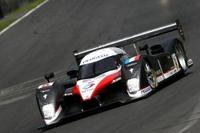1,000 KM of Valencia: a chance to gain further experience
 In the wake of the superb victory of Marc Gene and Nicolas Minassian’s Peugeot 908 HDi FAP at the high-speed circuit of Monza at an average speed of more than 200kph, Team Peugeot Total is now looking to pursue the car’s development at a very different type of track as the 2007 Le Mans Series moves on to Valencia.
In the wake of the superb victory of Marc Gene and Nicolas Minassian’s Peugeot 908 HDi FAP at the high-speed circuit of Monza at an average speed of more than 200kph, Team Peugeot Total is now looking to pursue the car’s development at a very different type of track as the 2007 Le Mans Series moves on to Valencia.The Spanish venue is indeed much slower, with only the start/finish straight providing any sort of break from the otherwise twisty layout. In spite of the fact that the organisers have purposely limited the number of cars that can race, it promises to be even more difficult to overtake at Valencia than it was at Monza where Peugeot's drivers complained about the trouble they encountered overtaking certain competitors.
To shed a little light on aspects of the 2007 Le Mans Series regulations that may not be totally clear to outside observers, Peugeot Sport’s Technical Director Bruno Famin goes over a certain number of points…
Tyres: “The regulations do not stipulate a maximum limit regarding the number of tyres that can be used. As a rule, Michelin has two types of compound available. However, just one set of tyres may be used for qualifying and the same tyres must be run on the car for the first stint of the race.”
Traction control: “The Peugeot 908 is equipped with a traction control system, although we try to use it as little as possible. That said, at a twisty venue like Valencia, it will be important to keep the high amount of torque generated by the 908’s HDi engine in check!
Aerodynamics: “The overall aerodynamic loads involved are probably higher than those seen in Formula 1, since the prototypes’ covered wheels produce less drag. The top speed reached by the 908 at Monza was 300kph for an average lap speed of 220kph during qualifying.”
Onboard signals: “For the time being, although a number of different warning signals are available to them, the drivers do not benefit from the onboard display on the steering wheel of information relating to the presence of blue or red flags, for example, or the presence of the safety car. This information is only communicated by radio.”
Pit stops: “When a car pits, it must first be refuelled before its tyres can be changed. At Monza, we were able to run two stints with the same tyres and the drivers also double stinted. The average time spent in the pits for fuel and tyres is approximately 50 seconds. The maximum authorised speed in the pit-lane is 60kph.”
Crash tests: “The 908 HDi FAP passed the different homologation tests without difficulty. These included crash testing of the body structure and steering column, as well as the application to the car of loads of up to 13 tonnes at different angles.”
In addition to the 908 HDi FAP’s resounding victory first time out at Monza, the Italian round gave Team Peugeot Total an opportunity to work calmly and good progress was made. The occasional problems encountered during the different test sessions helped further the development of the 908 and the team was also able to fine-tune the car’s aerodynamic balance. All the data recorded during the race will be used to prepare for Valencia, as well as for Le Mans which is another extremely fast circuit. A final endurance run prior to the Le Mans 24 Hours race itself was organised at Le Castellet/Paul Ricard, France, on April 26-28.
Nicolas Minassian (N°7 908 HDi FAP): “Following our result at Monza, we are more fired up than ever and we all want to do even better. We tested at Valencia at the end of February. It’s a more physically demanding circuit than somewhere like Monza, but it’s also interesting and technically challenging from the drivers’ point of view. You need a good mechanical set-up because traction is very important. You also need to be very careful in traffic. There’s a chance we will see a lot of the safety car, so getting your strategy right is very important.”
Marc Gene (N°7 908 HDi FAP): “I obviously know Valencia very well. It’s not far from my home and I generally travel there by car. I was the first driver to test a Formula 1 car at Valencia – in a Minardi – and I have done a fair amount of F1 testing there since. I have many friends at the circuit and it's always a pleasure to go back.
“The track is very demanding and very twisty, including some very slow turns. It promises to be a tough race, not only for the tyres but also for the drivers because it can be very tiring, both mentally and physically. You get very few chances to catch your breath.”

